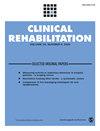Clinical effectiveness of cardiac rehabilitation and barriers to completion in patients of low socioeconomic status in rural areas: A mixed-methods study
IF 2.6
3区 医学
Q1 REHABILITATION
引用次数: 0
Abstract
ObjectiveTo investigate cardiac rehabilitation utilisation and effectiveness, factors, needs and barriers associated with non-completion.DesignWe used the mixed-methods design with concurrent triangulation of a retrospective cohort and a qualitative study.SettingEconomically disadvantaged areas in rural Australia.ParticipantsPatients (≥18 years) referred to cardiac rehabilitation through a central referral system and living in rural areas of low socioeconomic status.Main measuresA Cox survival model balanced by inverse probability weighting was used to assess the association between cardiac rehabilitation utilization and 12-month mortality/cardiovascular readmissions. Associations with non-completion were tested by logistic regression. Barriers and needs to cardiac rehabilitation completion were investigated through a thematic analysis of semi-structured interviews and focus groups (n = 28).ResultsAmong 16,159 eligible separations, 44.3% were referred, and 11.2% completed cardiac rehabilitation. Completing programme (HR 0.65; 95%CI 0.57–0.74; p < 0.001) led to a lower risk of cardiovascular readmission/death. Living alone (OR 1.38; 95%CI 1.00–1.89; p = 0.048), having diabetes (OR 1.48; 95%CI 1.02–2.13; p = 0.037), or having depression (OR 1.54; 95%CI 1.14–2.08; p = 0.005), were associated with a higher risk of non-completion whereas enrolment in a telehealth programme was associated with a lower risk of non-completion (OR 0.26; 95%CI 0.18–0.38; p < 0.001). Themes related to logistic issues, social support, transition of care challenges, lack of care integration, and of person-centeredness emerged as barriers to completion.ConclusionsCardiac rehabilitation completion was low but effective in reducing mortality/cardiovascular readmissions. Understanding and addressing barriers and needs through mixed methods can help tailor cardiac rehabilitation programmes to vulnerable populations and improve completion and outcomes.农村地区社会经济地位较低的患者完成心脏康复的临床效果和障碍:混合方法研究
目标调查心脏康复的利用率和有效性,以及与未完成康复相关的因素、需求和障碍.设计我们采用了混合方法设计,同时对回顾性队列研究和定性研究进行了三角测量.研究地点澳大利亚农村地区的经济落后地区.参与者通过中央转诊系统转诊至心脏康复中心、生活在社会经济地位较低的农村地区的患者(≥18岁)。主要测量指标采用逆概率加权平衡的Cox生存模型来评估心脏康复利用率与12个月死亡率/心血管再入院率之间的关系。通过逻辑回归检验了与未完成康复的关系。通过对半结构式访谈和焦点小组(n = 28)进行专题分析,调查了完成心脏康复的障碍和需求。结果在 16159 名符合条件的离职者中,44.3% 的人被转诊,11.2% 的人完成了心脏康复。完成康复计划(HR 0.65; 95%CI 0.57-0.74; p < 0.001)可降低心血管疾病再入院/死亡的风险。独居(OR 1.38;95%CI 1.00-1.89;p = 0.048)、糖尿病(OR 1.48;95%CI 1.02-2.13;p = 0.037)或抑郁(OR 1.54;95%CI 1.14-2.08;p = 0.005)与较高的未完成风险相关,而参加远程保健计划与较低的未完成风险相关(OR 0.26; 95%CI 0.18-0.38; p <0.001)。与后勤问题、社会支持、护理过渡挑战、缺乏护理整合以及以人为本有关的主题成为完成计划的障碍。通过混合方法了解并解决障碍和需求,有助于为弱势人群量身定制心脏康复计划,提高完成率和效果。
本文章由计算机程序翻译,如有差异,请以英文原文为准。
求助全文
约1分钟内获得全文
求助全文
来源期刊

Clinical Rehabilitation
医学-康复医学
CiteScore
5.60
自引率
6.70%
发文量
117
审稿时长
4-8 weeks
期刊介绍:
Clinical Rehabilitation covering the whole field of disability and rehabilitation, this peer-reviewed journal publishes research and discussion articles and acts as a forum for the international dissemination and exchange of information amongst the large number of professionals involved in rehabilitation. This journal is a member of the Committee on Publication Ethics (COPE)
 求助内容:
求助内容: 应助结果提醒方式:
应助结果提醒方式:


